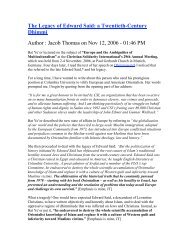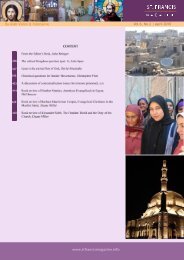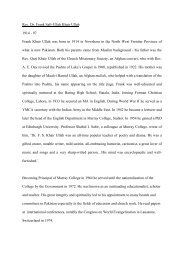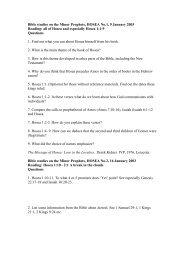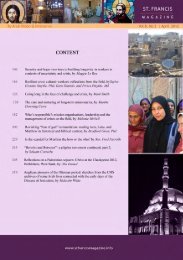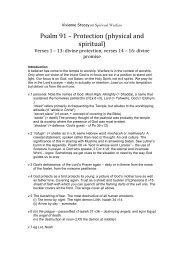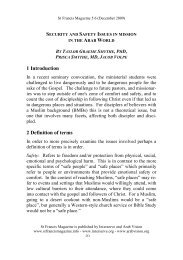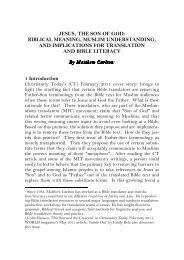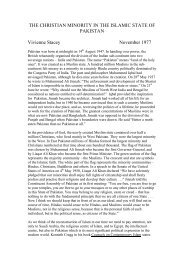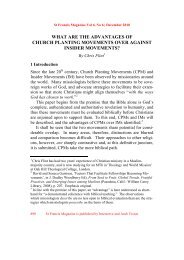download the pdf - St.Francis Magazine
download the pdf - St.Francis Magazine
download the pdf - St.Francis Magazine
Create successful ePaper yourself
Turn your PDF publications into a flip-book with our unique Google optimized e-Paper software.
<strong>St</strong> <strong>Francis</strong> <strong>Magazine</strong> Vol 8, No 4 | August 2012<br />
agree, however, without reminder, that “[t]he decision of that<br />
council was to leave Gentiles in <strong>the</strong>ir culture.” (Hoefer 2007b: 131)<br />
Also, just as within Acts <strong>the</strong> question of what <strong>the</strong> apostles were doing<br />
in <strong>the</strong> Temple can raise multiple possible answers (Sleeman<br />
2009: 105), a lot of interpretive scope lies within <strong>the</strong> relative degree<br />
of freedom and connection between ‘movements’ (cf. Higgins 2009:<br />
79-80).<br />
Within and beyond such exegetical considerations, <strong>the</strong> debate’s<br />
predominantly and increasingly dichotomous nature risked denying<br />
that C1 and C5 are not <strong>the</strong> only options for ministry in Muslim settings.<br />
Tennent (2006: 110-113) took exception to various false dichotomies<br />
inherent within Massey (2004c) and Hoefer (2005), and<br />
objected to <strong>the</strong> individualistic stance he identified in Brown (2000b).<br />
Tennent also observed that many defences offered for C5 were<br />
equally applicable to C4 ministries, and thus achieved insufficient<br />
traction regarding <strong>the</strong> pivotal C5 issue of identity, especially selfidentity.<br />
At <strong>the</strong> close of his consideration of Acts 15:19-20, for example,<br />
he concluded: “while I find Acts 15 a compelling defence for<br />
C-4, I am less convinced that it provides a sufficient basis for justifying<br />
C-5.” (Tennent 2006: 107) He drew similar conclusions regarding<br />
two o<strong>the</strong>r passages frequently used to underpin C5 arguments,<br />
namely 1 Corinthians 7:20 and 9:19-22, and saw 2 Kings 5:18-19 as<br />
too ambiguous to contribute substantially to <strong>the</strong> contextualisation<br />
discussion. Conversely, he judged Hebrews 10:25 to argue against a<br />
C5 stance among first-century Jewish believers. O<strong>the</strong>rs shared<br />
<strong>the</strong>se concerns (e.g. Waterman 2007: 61).<br />
Dichotomies thrive on loosely defined terms. Higgins (2006:<br />
117-119) judged that Tennent had assumed, but not clearly defined,<br />
<strong>the</strong> categories ‘Muslim’ and ‘church’ in both <strong>the</strong>ir historical and contemporary<br />
expressions, but he also noted that this was also characteristic<br />
of both sides of <strong>the</strong> wider C5 debate. Within C5 itself, Higgins<br />
(2006: 121-123) went on to outline three possible stances depending<br />
on one’s prior conclusions regarding Islam’s origins, early<br />
history and subsequent development. Beyond this, even <strong>the</strong> term<br />
‘Muslim’ can have very different connotations between localities and<br />
among different ethnic groups (Tee 2007: 1-2). Simultaneously,<br />
<strong>St</strong> <strong>Francis</strong> <strong>Magazine</strong> is a publication of Interserve and Arab Vision 473




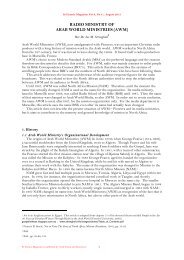
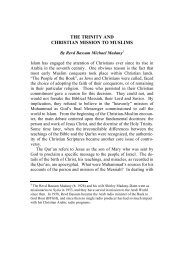
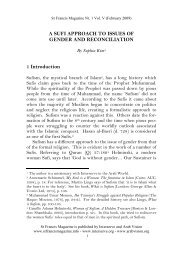
![Reflections on Surah Fatiha and the Lord's Prayer[1] - St.Francis ...](https://img.yumpu.com/49377951/1/184x260/reflections-on-surah-fatiha-and-the-lords-prayer1-stfrancis-.jpg?quality=85)
